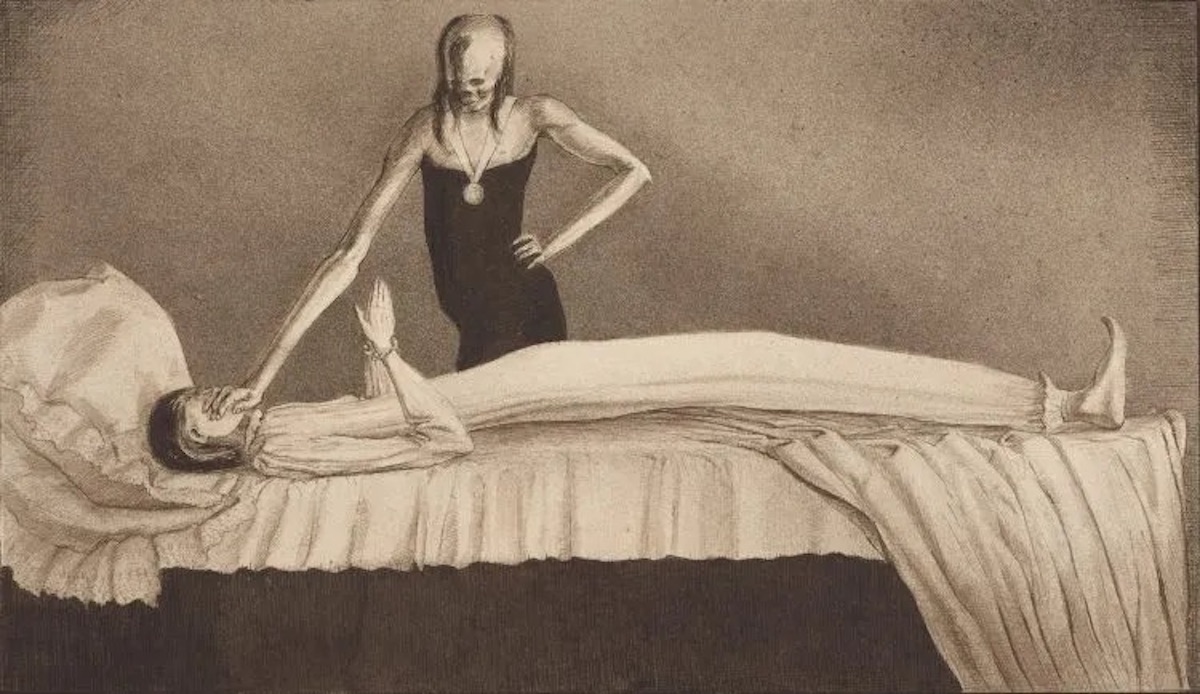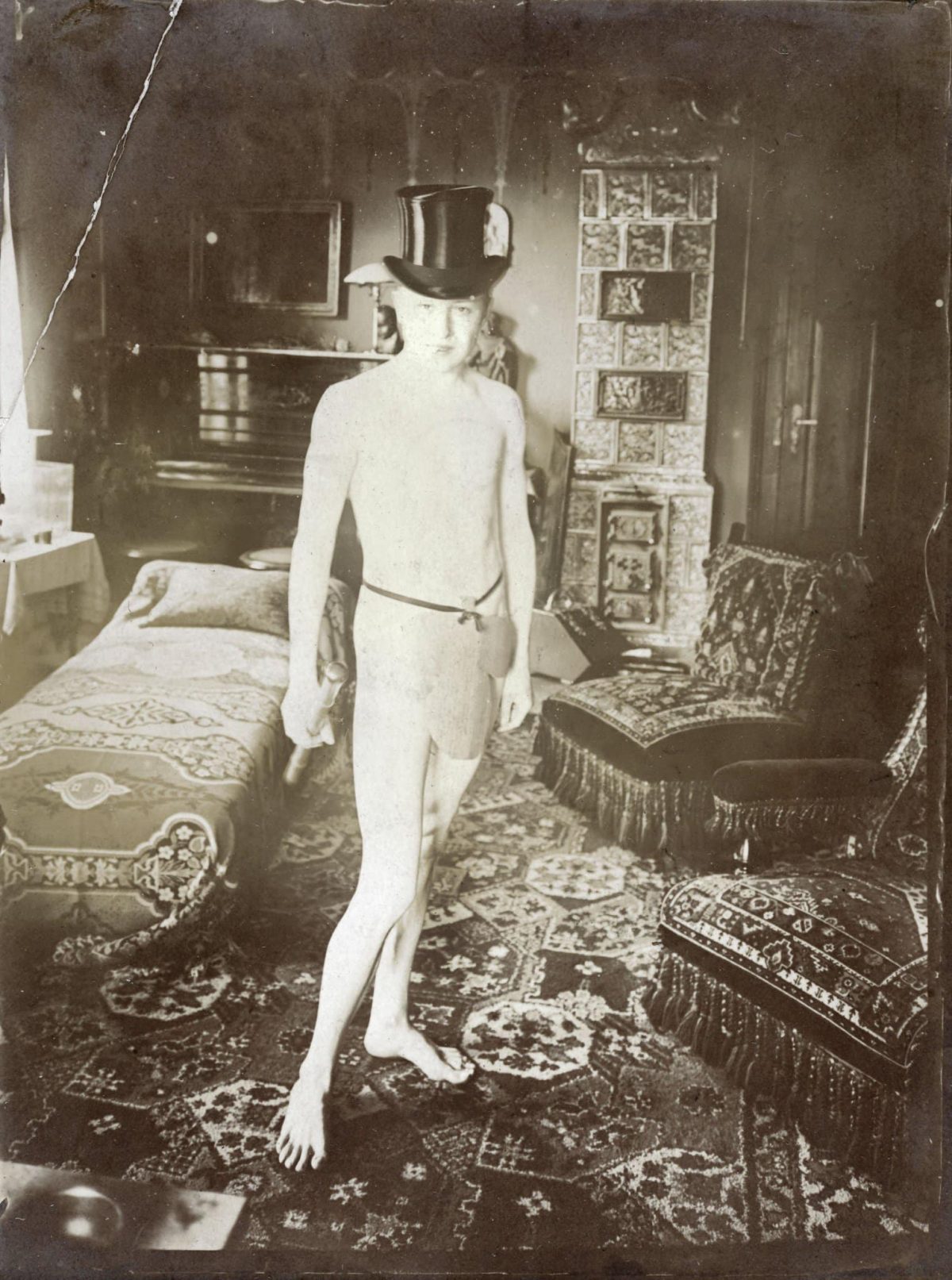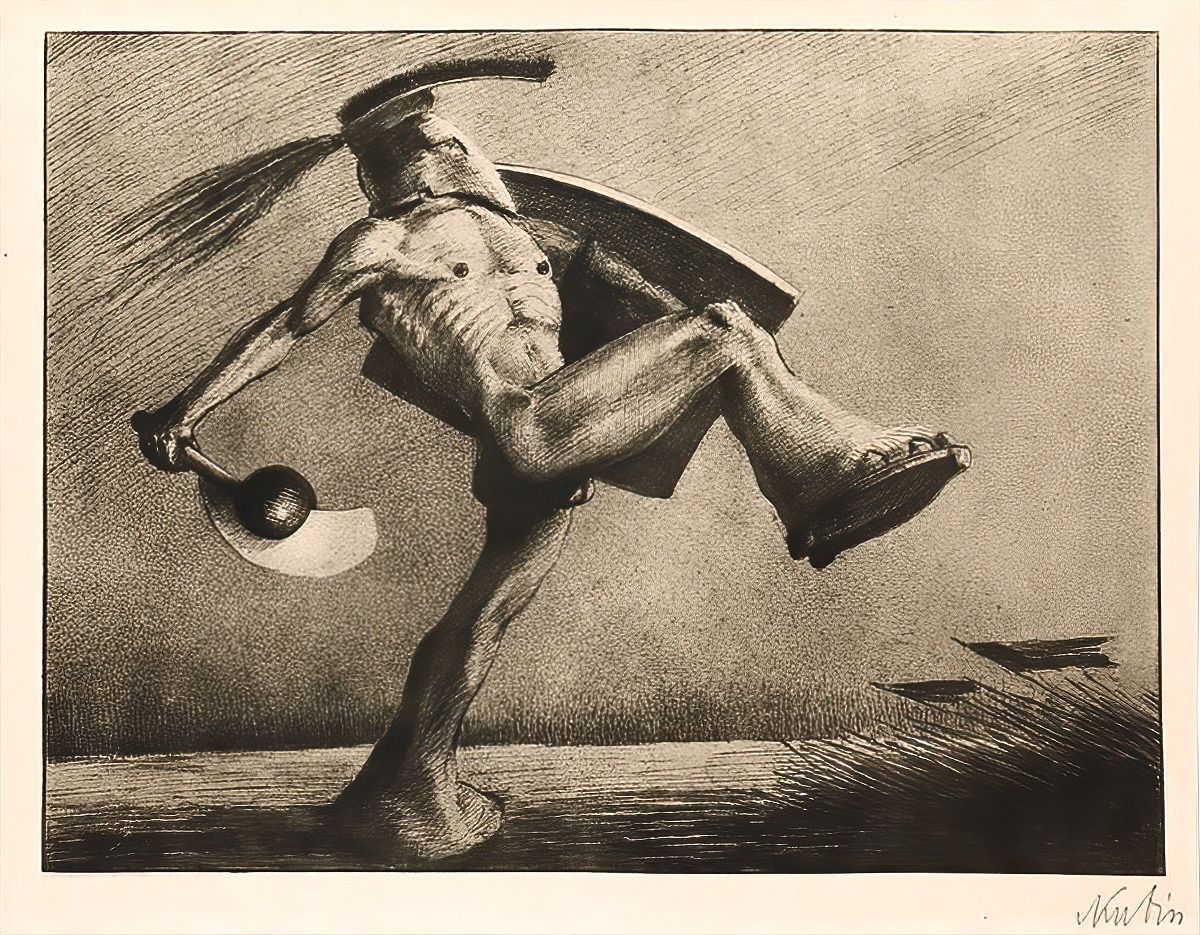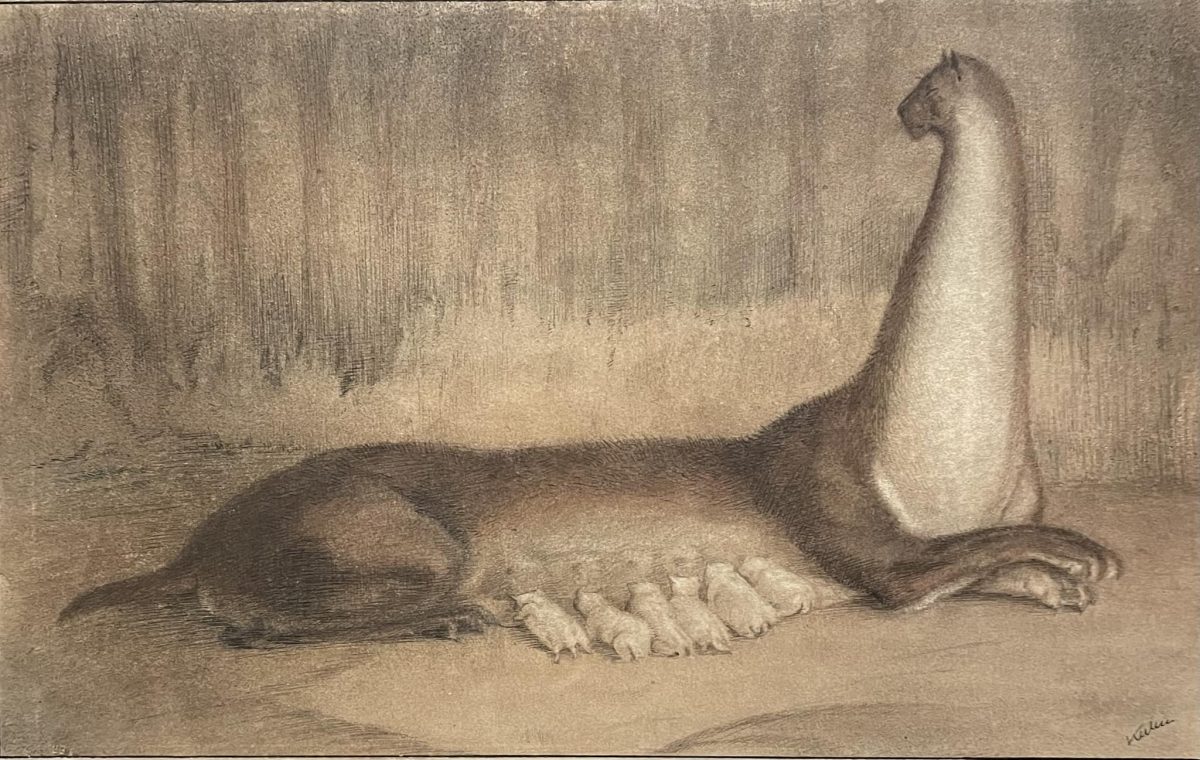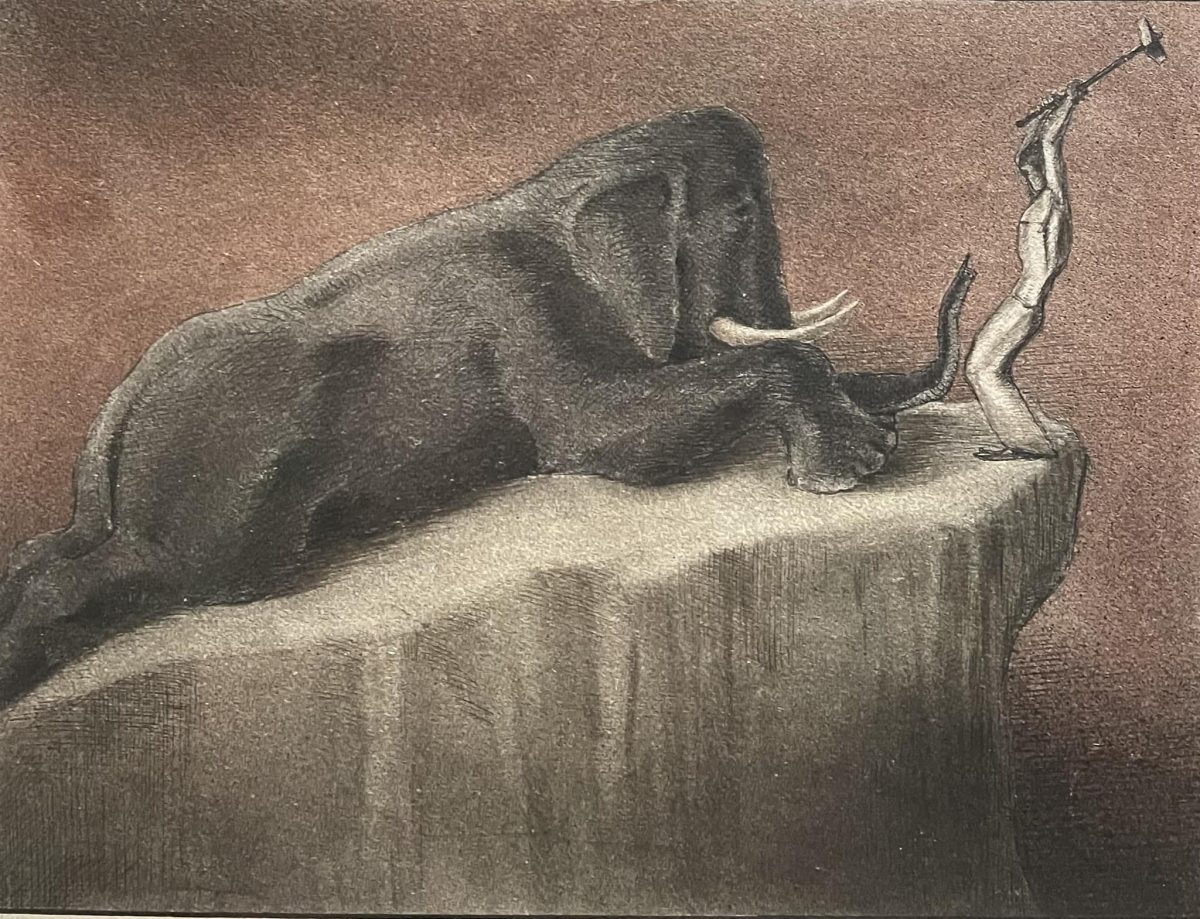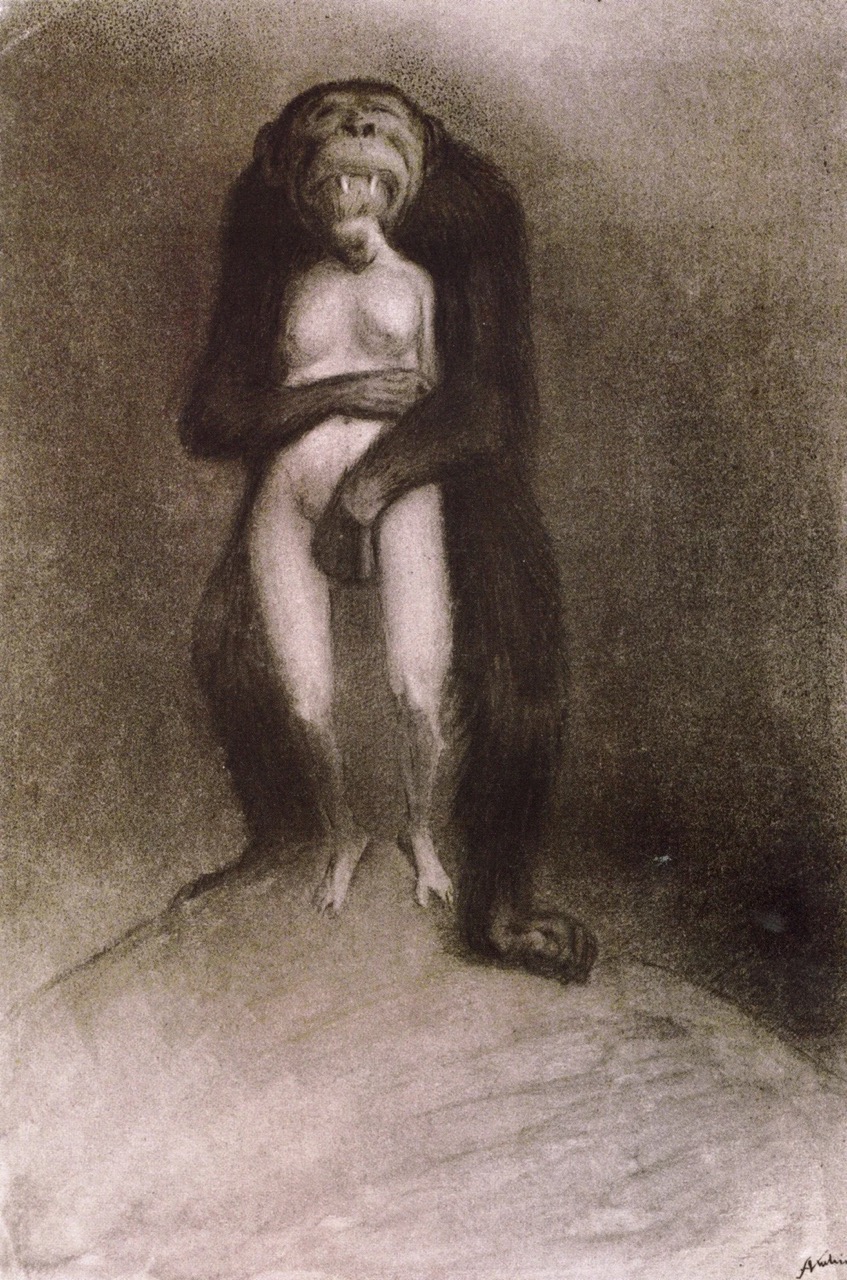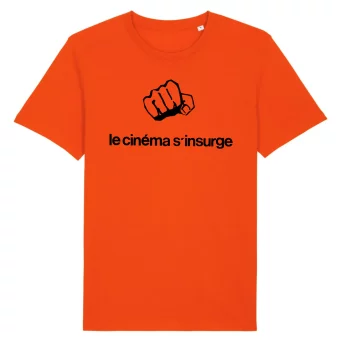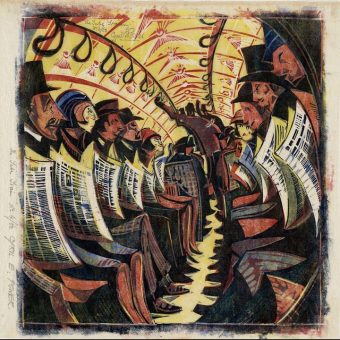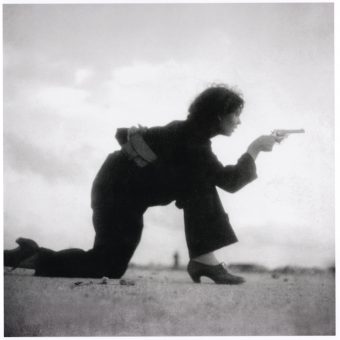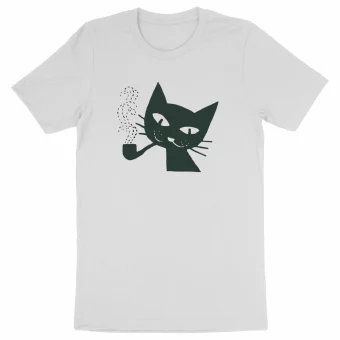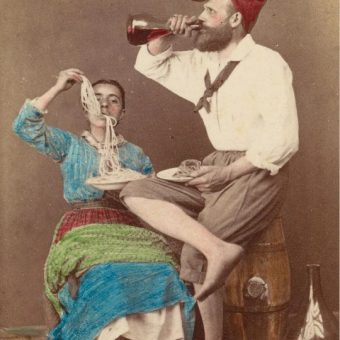“I definitely prefer the four-horned cow to the one having only two horns”
– Alfred Kubin (10 April 1877 – 20 August 1959), 1911
In Alfred Kubin’s bizarre and horrific illustrations, humans appear as skeletal, ghost-like creatures or hideously deformed things. They share surreal and hellish landscapes with monsters, vermin and peculiar animals. His friend, the Jewish Austrian-Czech writer Franz Kafka, who admired Kubin as a novelist as well as a visual artist, noted in 1911 that the artist “looks different in age, size, and strength according to whether he is sitting, standing, wearing just a suit, or an overcoat”. As in appearance, so in art, Kubin was unsettled.
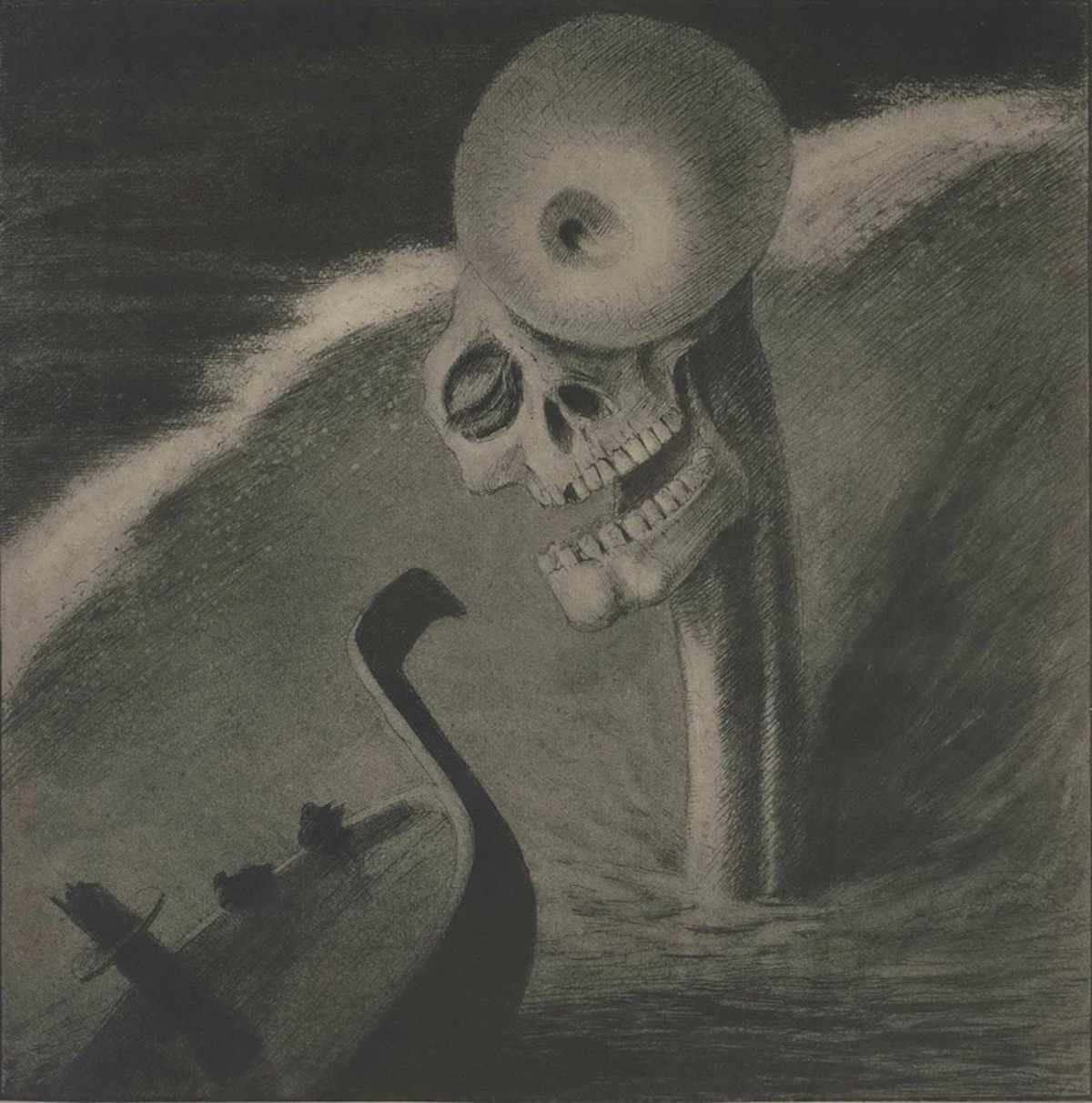
Alfred Kubin: The Horror
Following his first solo exhibition in 1902, and in 1903, the creation of his Weber portfolio with fifteen of Kubin’s drawings German weekly Berliner Illustrirte (1892 to 1945) published an article Kubin described as the best article ever written about his early work:,
“The characteristic feature of this strange art is that it attempts to depict the extrasensory, to provide symbols for the mysterious forces to which we are subjected in our daily lives but which we do not know—indeed, that is revealed to us only in wild dreams and fantasies, in states of clairvoyant nervous strain…
“This art always dreams of the last things in apocalyptic fantasy; its beings and forms are not of this world, and you cannot measure them by the ruler of correctness or anatomical possibility; they are complete distortion, total gruesome exaggeration; just as their landscapes dream away in the eternal twilight behind time and space. But you will always find one thing in this art, which dispenses with every depiction, every illustration of being, it has a convincing power to make things present and will grip you and sweep you away, conveying to you ideas and moods of uncanny reality that will burn themselves into your brain as if with hot iron punches…the suggestion of this foreboding art of the soul, the rare, the distant, the lustfully dreadful…is always powerful and enduring.”
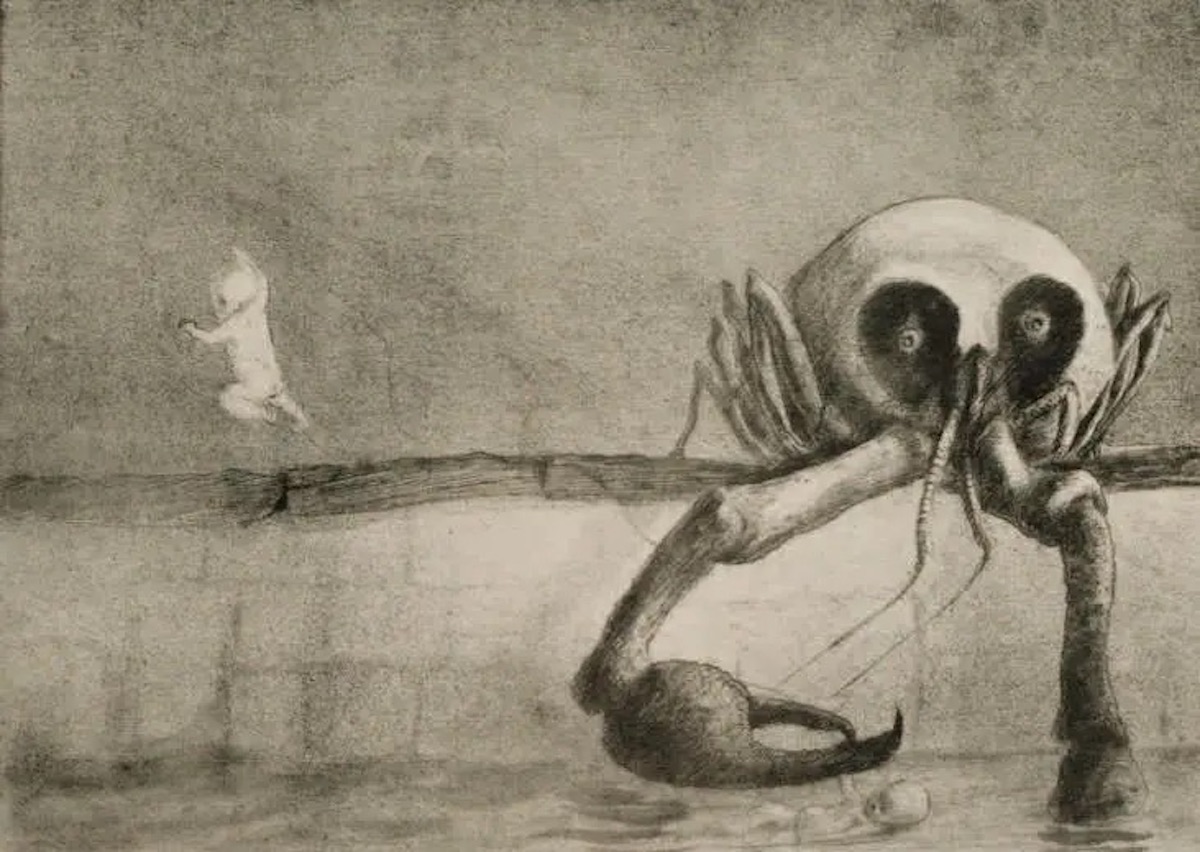
Alfred Kubin- The Moment of Birth, 1903
Alfred Kubin: The Other Side (Die andere Seite)
If Alfred Kubin’s images aren’t enough to give you an insight into this artist’s anxious mind, you can read his “fantastical novel”, The Other Side (1907), The book’s action takes place in a surreal world, “a place of asylum for those who are disgusted with modern culture.”
Here’s the plot (Via: Suite101):
“The Other Side tells the story of a German artist who is visited one day by a mysterious stranger claiming to be an emissary of old school friend named Patera. Furthermore the stranger states that this Patera is now the richest man in the world and has been building an idyllic community on a large piece of land he has purchased specifically for the purpose – this community goes under the name of the Dream Kingdom and has a capital city, Perle.
“Since taking possession of the land – and surrounding it with a large wall with a single gate – Patera has apparently been sending his servants on missions around the world to purchase specific objects of all kinds, seemingly randomly chosen, to furnish it. Patera’s aims in creating such a place are not made clear but along with this information the stranger brings an invitation for the narrator to join the band of dreamers who are already living in the new country.
“After some deliberation the artist and his wife agree to travel to the Dream Kingdom, leaving behind all their worldly possessions and accepting instead a large sum of money which will cover their travel expenses and allow them to set themselves up on arrival in Perle. This sum of money is just one of many things that turn out to not be quite what they seem once in the Dream Kingdom…
“The first thing they notice is that the sky is always grey – that and the fact that everyone and everything seems to make no sense at all. The city is built of a hodge-podge of anachronistic buildings collected by Patera, the dress of the inhabitants is several decades out of fashion and money seems to change in value from minute to minute; furthermore people behave most extraordinarily making unsolicited deliveries of useless goods in the middle of the night and being hypnotized daily by the ‘great clock spell’…
“At this point a strange American turns up in Perle and begins loudly to announce that he intends to challenge its ineffective leader for the privilege of governing the Dream Kingdom. From here on in, things begin to get truly weird. The town is tormented by plagues of animals and insects, buildings collapse and earthquakes swallow people alive. Eventually the whole place is destroyed in a number of scenes which resemble the worst excesses of the Book of Revelation crossed with the fever dream of an insane depressive.
“The city and land itself which in some sense appear to be an actual manifestation of Patera’s dreaming subconscious finally give way, presumably as Patera himself dies (or wakes?) leaving virtually all of the inhabitants dead except for the narrator who survives to document the events.”
By way of an extract, the book’s narrator tells us what he observes through a peephole. And is preparation for it, it might help to know that when he was a child, a pregnant woman molested him, as he wrote: “I was just eleven and a half when I was involved in sexual games by an older woman, which upset me beyond measure and cast a shadow well into my manhood years.”
“All around there was grunting and groaning, interspersed with shrill screams and the occasional deep sigh. It was a quivering, heaving sea of naked flesh. Being completely unaffected myself, I was sensitive to the meaninglessly mechanical nature of this crude act. I couldn’t help seeing something grotesquely insect-like in the convulsive performance. There was a haze of blood over the whole area and the glare of the camp-fires flickered over the tangle of frenzied flesh, picking out this or that group. I still have a vivid picture of a bearded middle-aged a man squatting on the ground staring between the spread thighs of a pregnant woman and muttering mindlessly to himself. It was like a mad prayer.
“Suddenly I heard loud screeching nearby, of both exultation and pain. To my horror I saw that a blonde whore had castrated a drunk with her teeth. I could see his glassy eyes as he writhed in his own blood. Almost in the same moment, an axe descended; her victim had found an avenger. Masturbators withdrew to the dark of the tents while from farther away came cheering: our pets, caught up in the frenzy, were mating. But what made the deepest impression on me was the half-asleep, rather blank expression on all the faces, whether pale or flushed, which suggested that these poor people were not acting of their own free will. They were automata, machines which, once set in motion, continued to run on their own. Their minds must have been elsewhere.”
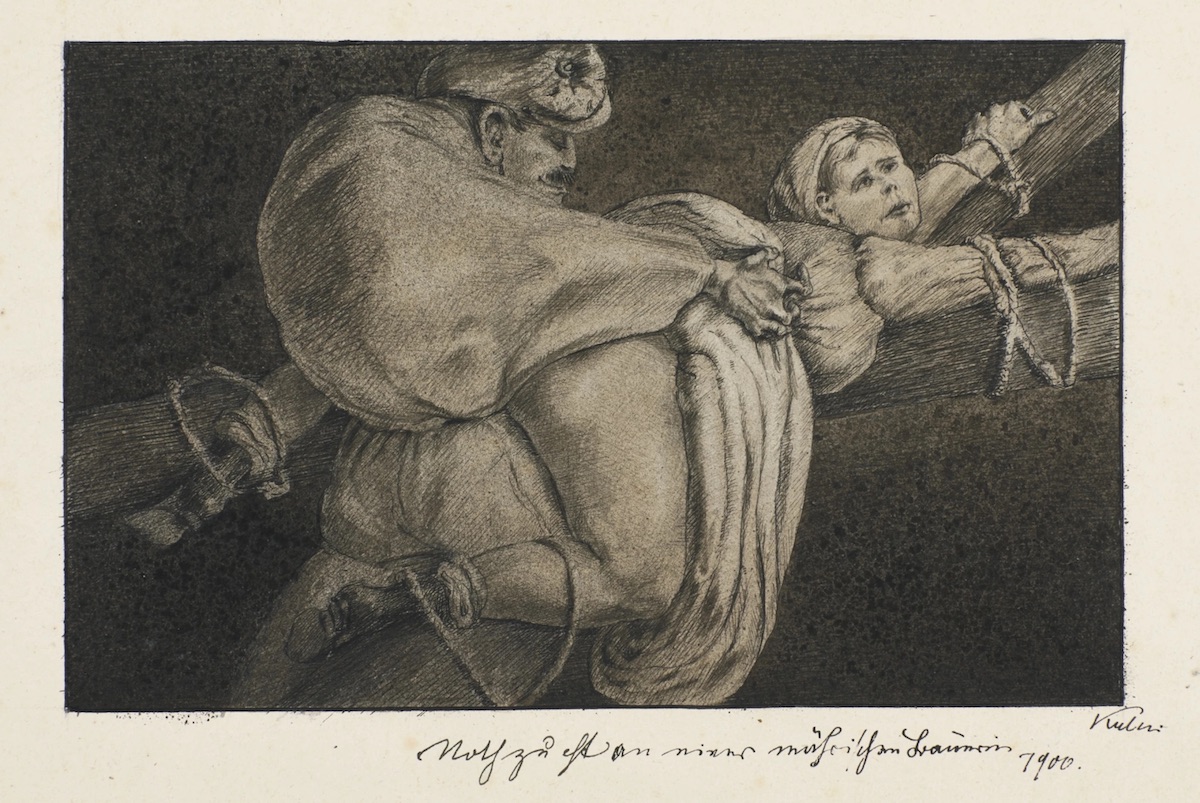
Alfred Kubin : Notzucht an einer mährischen Bäuerin (Violation of a Moravian farmer), 1900
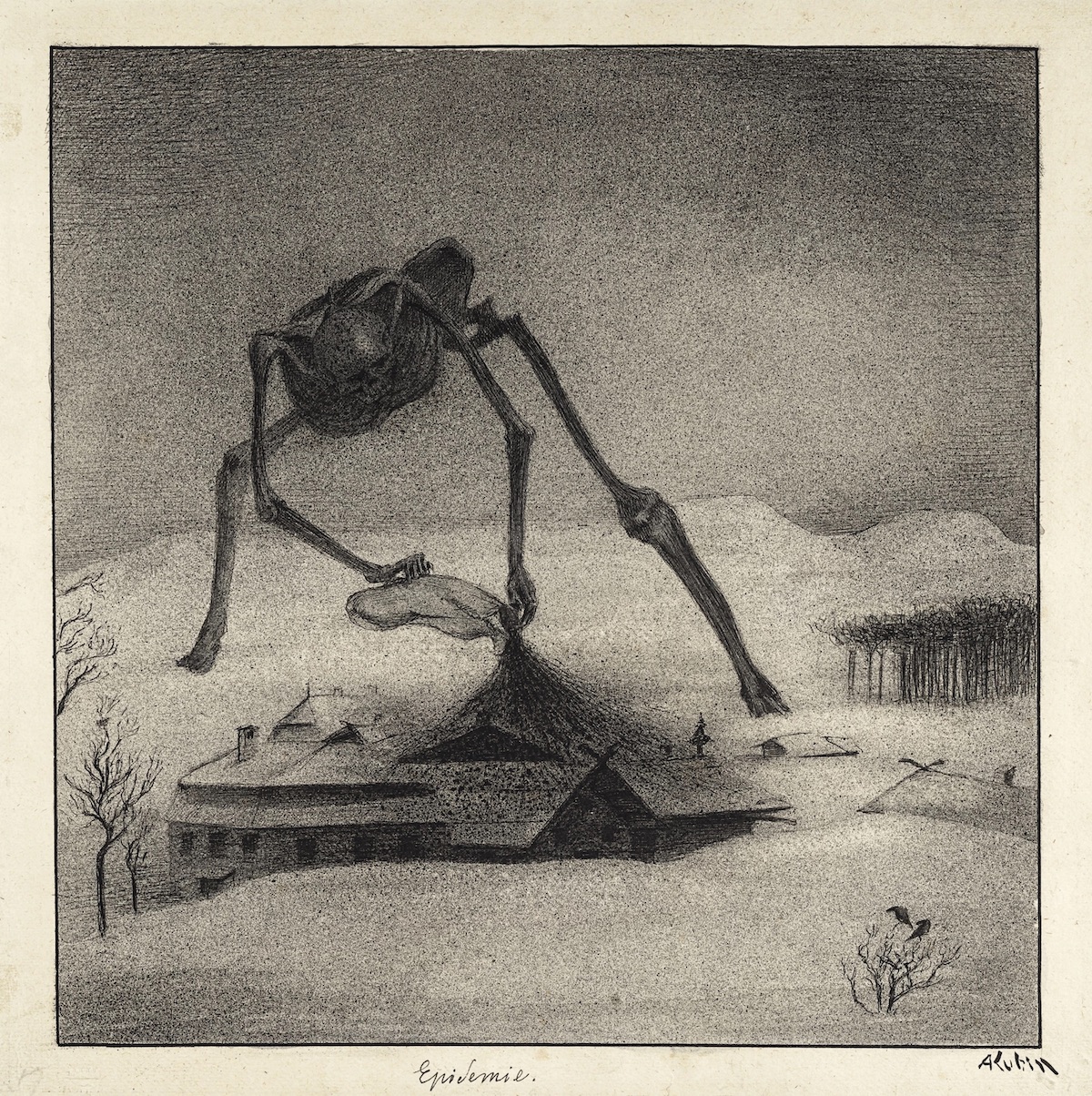
Epidemie (Epidemic) by
“I don’t create out of pleasure, but in order to forget all the disgust I feel toward myself and the whole world”
– Alfred Kubin, 1902
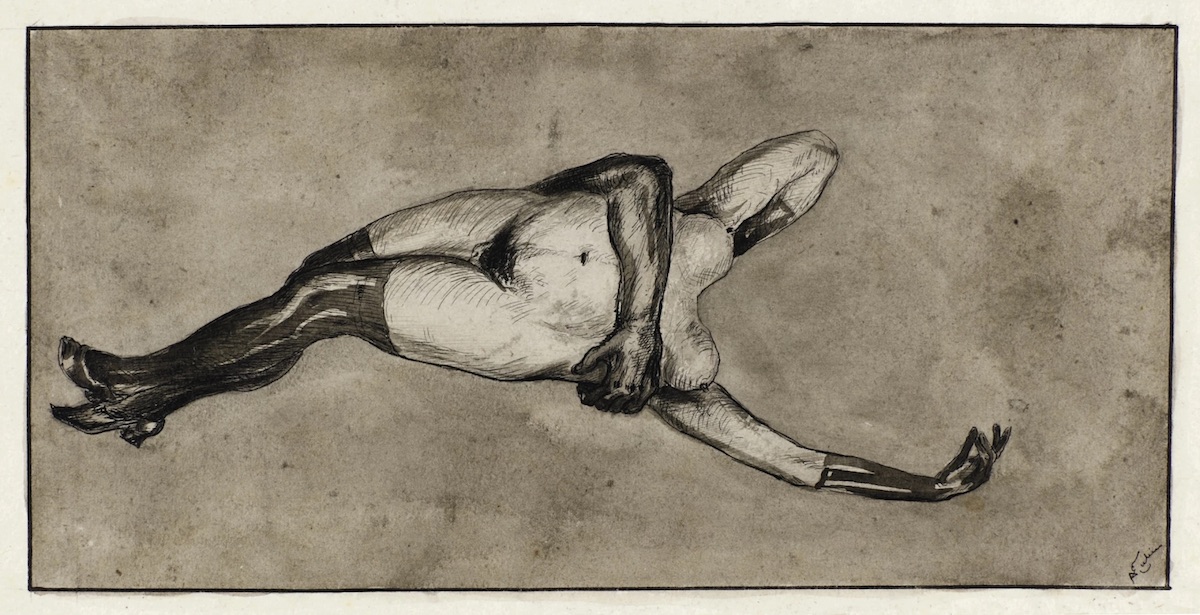
Alfred Kubin: Männlicher Arm mit weiblichem Akt (Male Arm with Female Nude) signed A Kubin (lower right) pen and brush and ink on paper . Executed circa 1898.
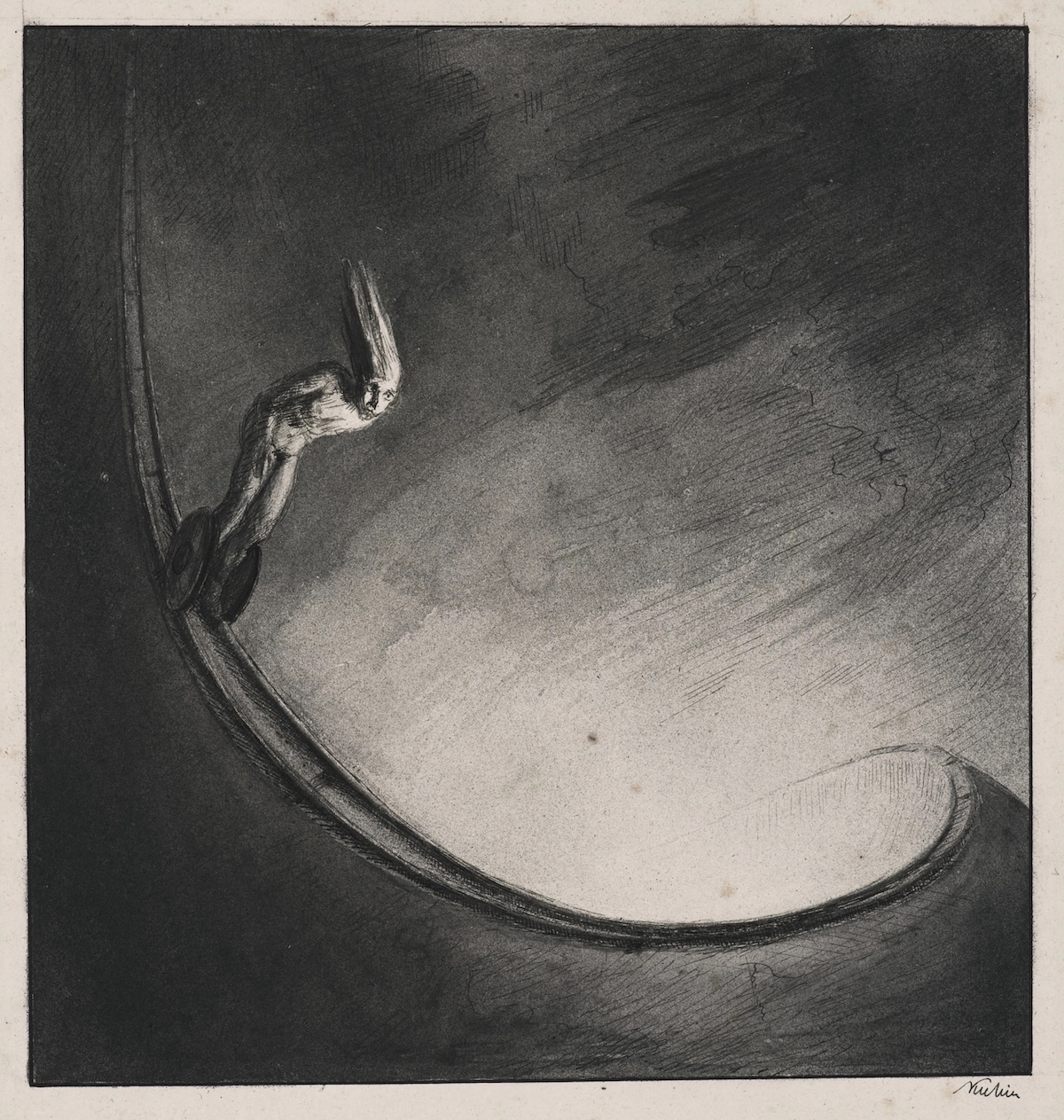
Alfred Kubin Der Mensch (The man)
Alfred Kubin: The Catharsis
Kubin was profoundly changed after seeing an exhibition of German artist Max Klinger’s (18 February 1857 – 5 July 1920) etchings in Munich in 1882. Something unusual happened to him that day:
“I grew moody… And now I was suddenly inundated with visions of pictures in black and white – it is impossible to describe what a thousand-fold treasure my imagination poured out before me. Quickly I left the theater, for the music and the mass of lights now disturbed me, and I wandered aimlessly in the dark streets, overcome and literally ravished by a dark power that conjured up before my mind strange creatures, houses, landscapes, grotesque and frightful situations…
“With my heart filled to bursting, I walked through the city and went to a variety show that night because I was looking for an impersonal yet noisy setting to free myself of a growing inner pressure. Something psychologically very strange and highly significant happened to me there. To this day, I do not quite understand it, although I have thought about it a lot.
“The faces around me seemed animalistic-human; all sounds took on a strange quality as if they were divorced from their source; and a mocking, moaning, and rumbling language that I could not understand seemed to have an eerie meaning that reverberated through me.”
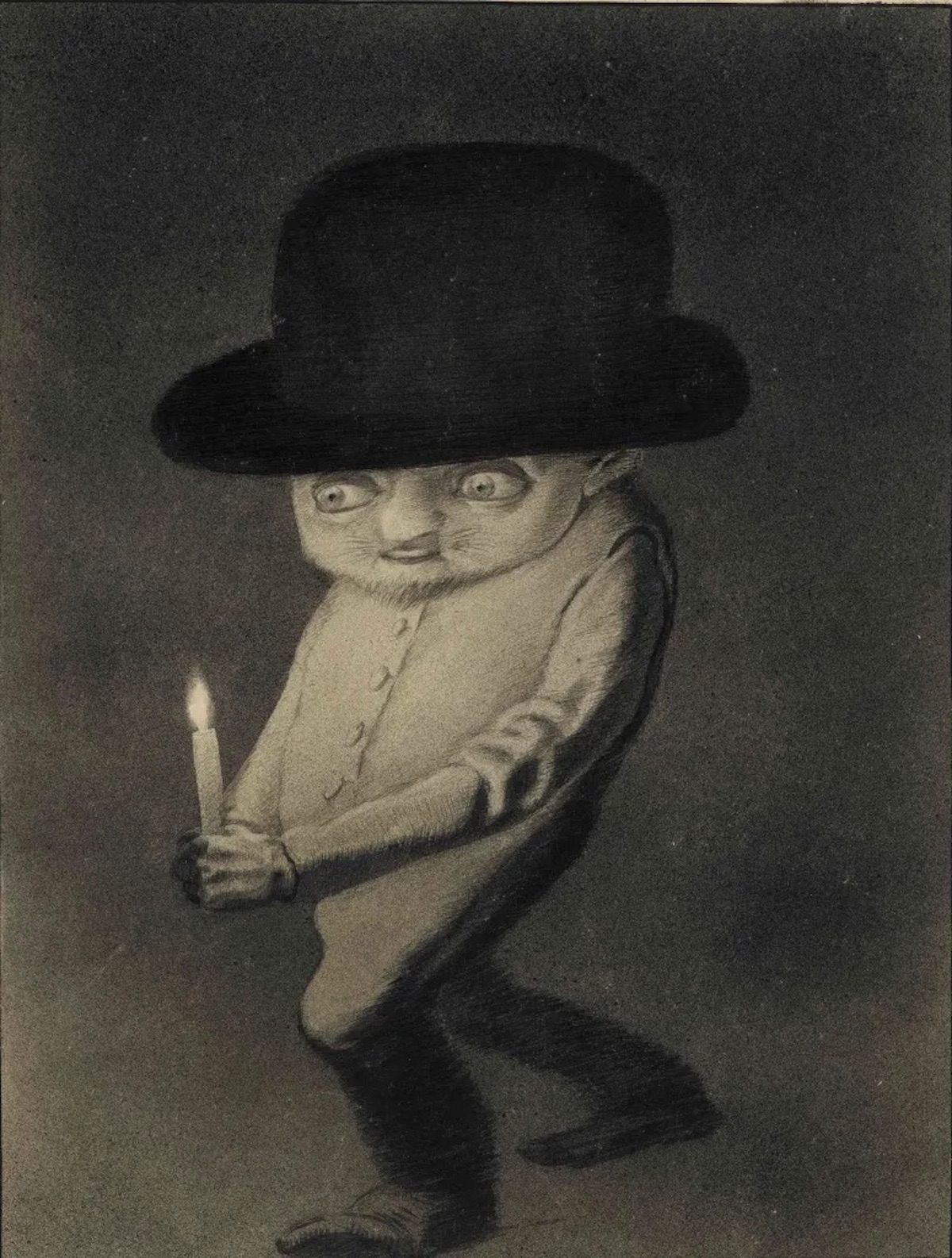
Zwerg mit Kerze (Dwarf with Candle; 1901:02), Alfred Kubin. Courtesy Richard Nagy
A Life Spent Waiting For Death
Alfred Kubin (10 April 1877 – 20 August 1959) was a Jewish Austrian artist, printmaker, illustrator, and occasional writer. Kubin is considered an important representative of Symbolism and Expressionism.
A loner and an individualist, Kubin created a body of work that is characterised by intense spiritual agony. His images often depict oppressive fantasy worlds. “Kubin drew fantastical beings, grotesque faces and ominous scenarios in which sexual anxieties, obsessions, anguish and the feeling of helplessness dominate. These themes expose the secret impulses and fears of the human psyche, which were examined by Sigmund Freud during his time.”
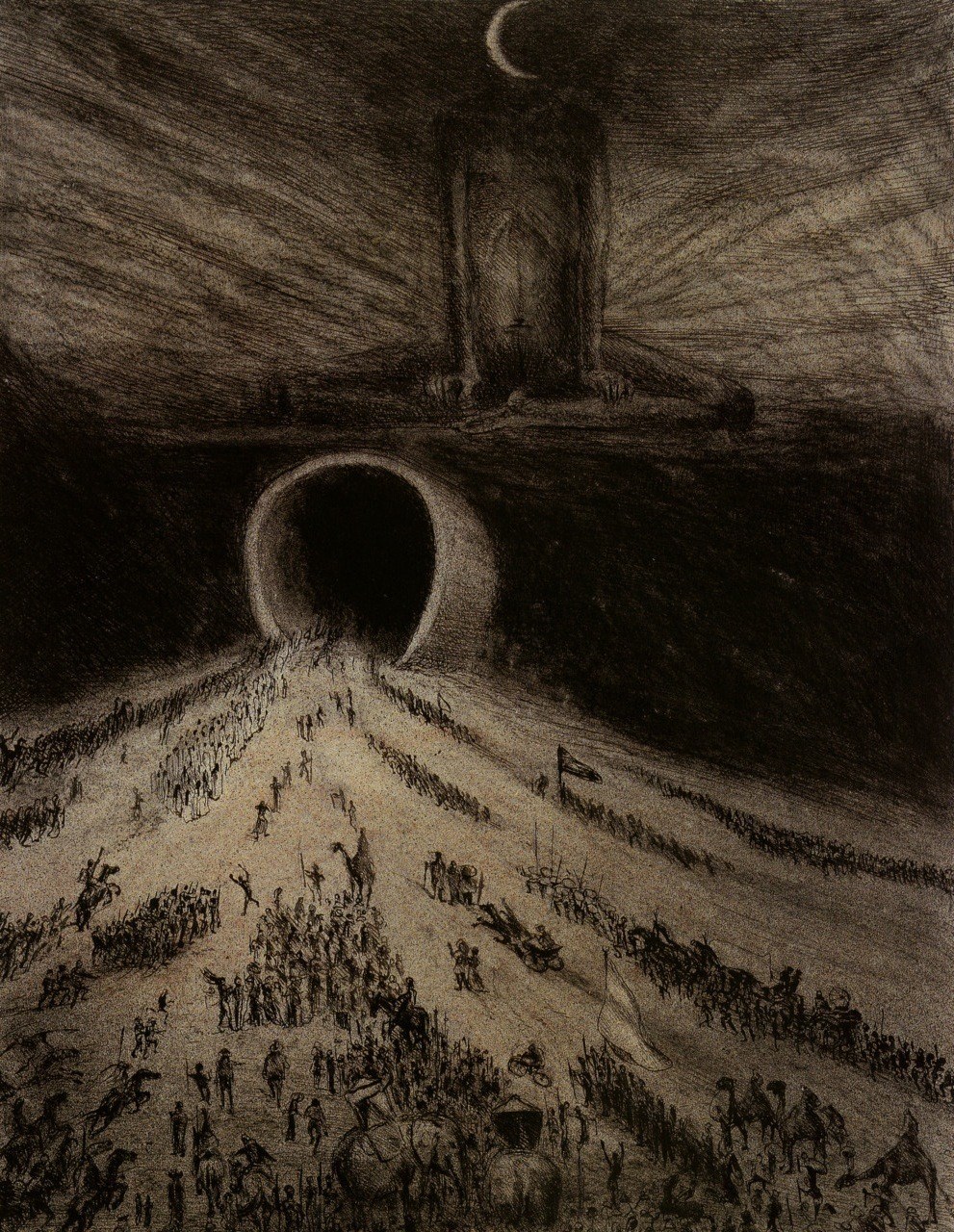
Alfred Kubin, The Way to Hell, 1904
Alfred Kubin had felt drawn to death since his childhood. Among other things, he was fascinated by corpses. His mother Johanna was the first person whose death young Kubin witnessed. He was thus forced to separate from the human being closest to him. Later, as an adolescent, he voluntarily frequented mortuaries and curiously observed how the fishermen in Zell am See, the small town where he grew up, recovered floaters from the lake on a regular basis. Once Kubin even said that his first love was a dead woman. All these impressions and his suicide attempt at his mother’s grave when he was not even twenty are reflected in his work. In Kubin’s art, evil lurks everywhere, and death has many faces: it manifests itself as an angel, a ghostly apparition, devil, the Reaper, a henchman, Death’s Bride, and numerous other figures. All of us will live to see their hour, go on their journey into the afterlife—and Kubin reminds us of this.
–Albertina Modern Museum, Vienna
A major part of the sheets deals with death and man’s inescapable fate. A horrible skull emerges from the waves; a male figure holds on to the tail of a snake over an abyss; a huge skeleton sows the seeds of an epidemic across a village; the only things left of an emaciated horse are skin and bones; the hand on the clock of death moves forward relentlessly; overpowering fate herds together a crowd of people. A motif Kubin frequently revisited over many years is war. One of the scenes shows a giant soldier about to trample an army with his hoofed elephant’s foot.”
– Albertina Modern
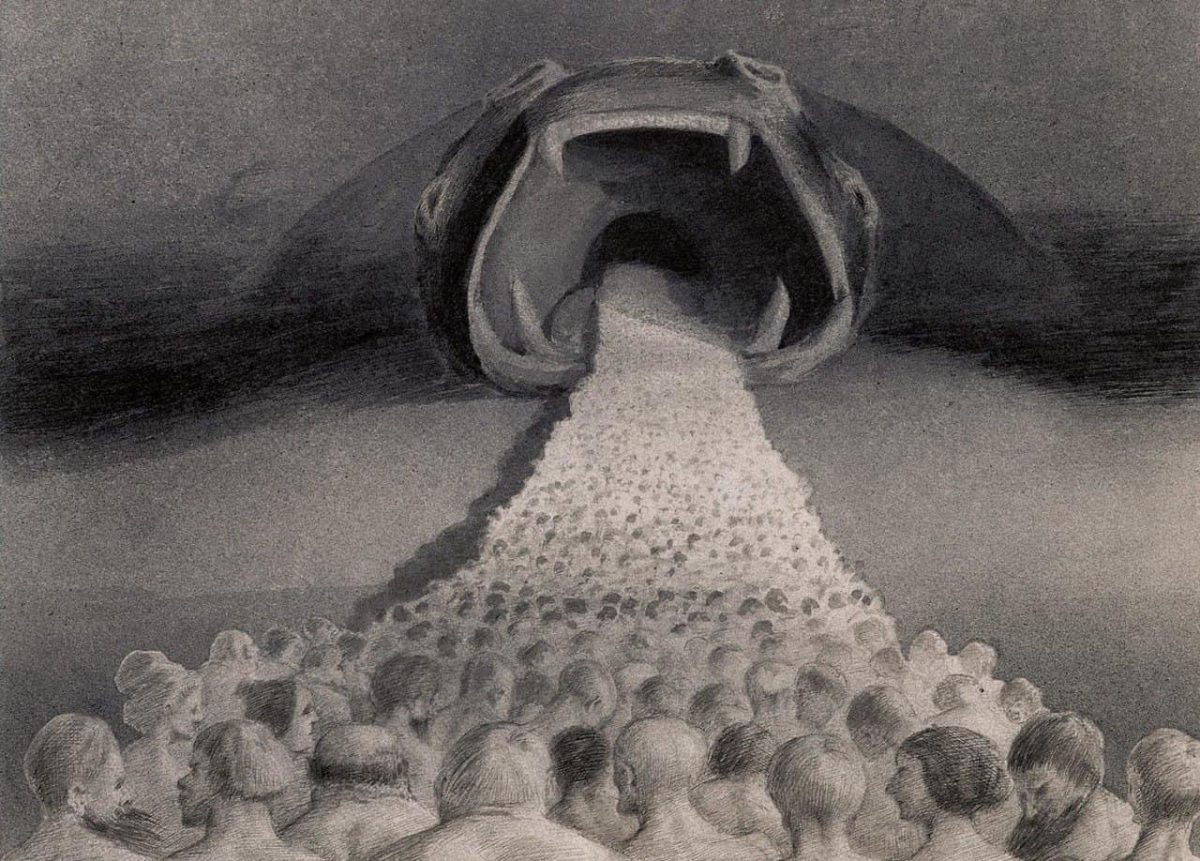
Into the Unknown, detail, 1900 – 1901, India ink, pen, watercolor
From 1906 until his death, he lived a withdrawn life in a Manor-House on a 12th-century estate in Zwickledt, Upper Austria. In 1938, at the Anschluss of Austria and Nazi Germany, his work was declared entartete Kunst or “degeneate art,”, but he managed to continue working during World War II.
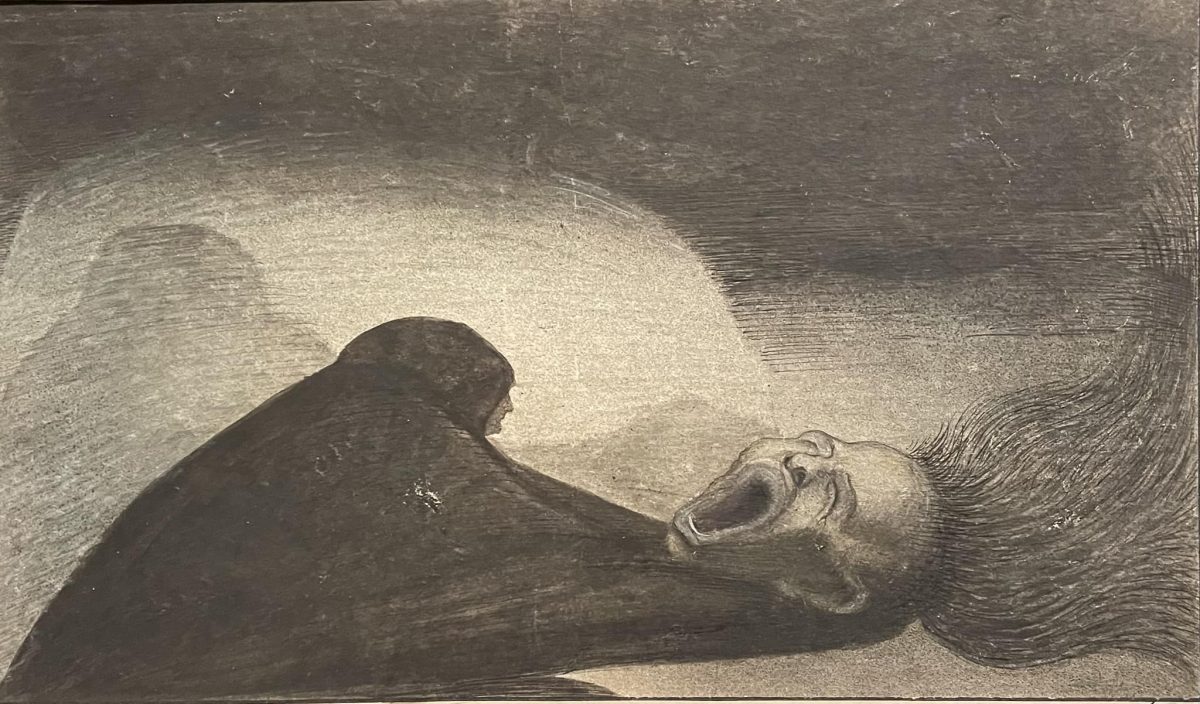
Bad Dream, ca. 1900, ink on paper.
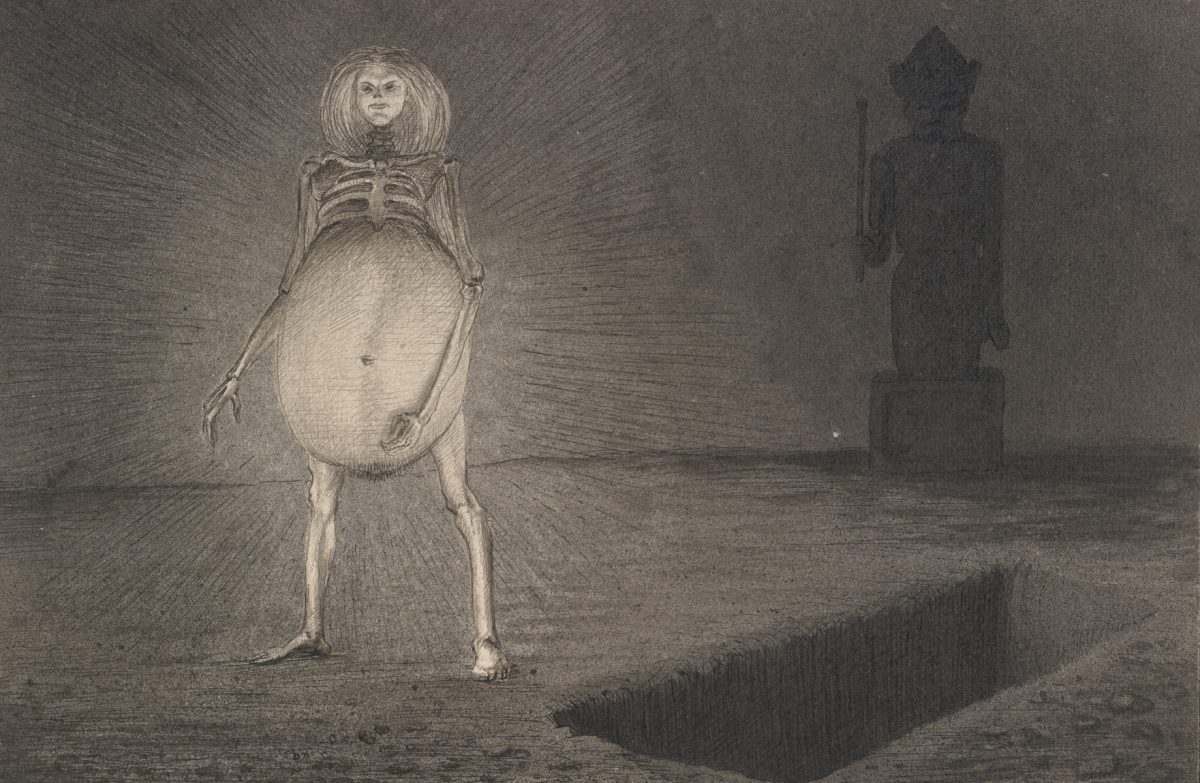
“The Egg”, ca. 1901
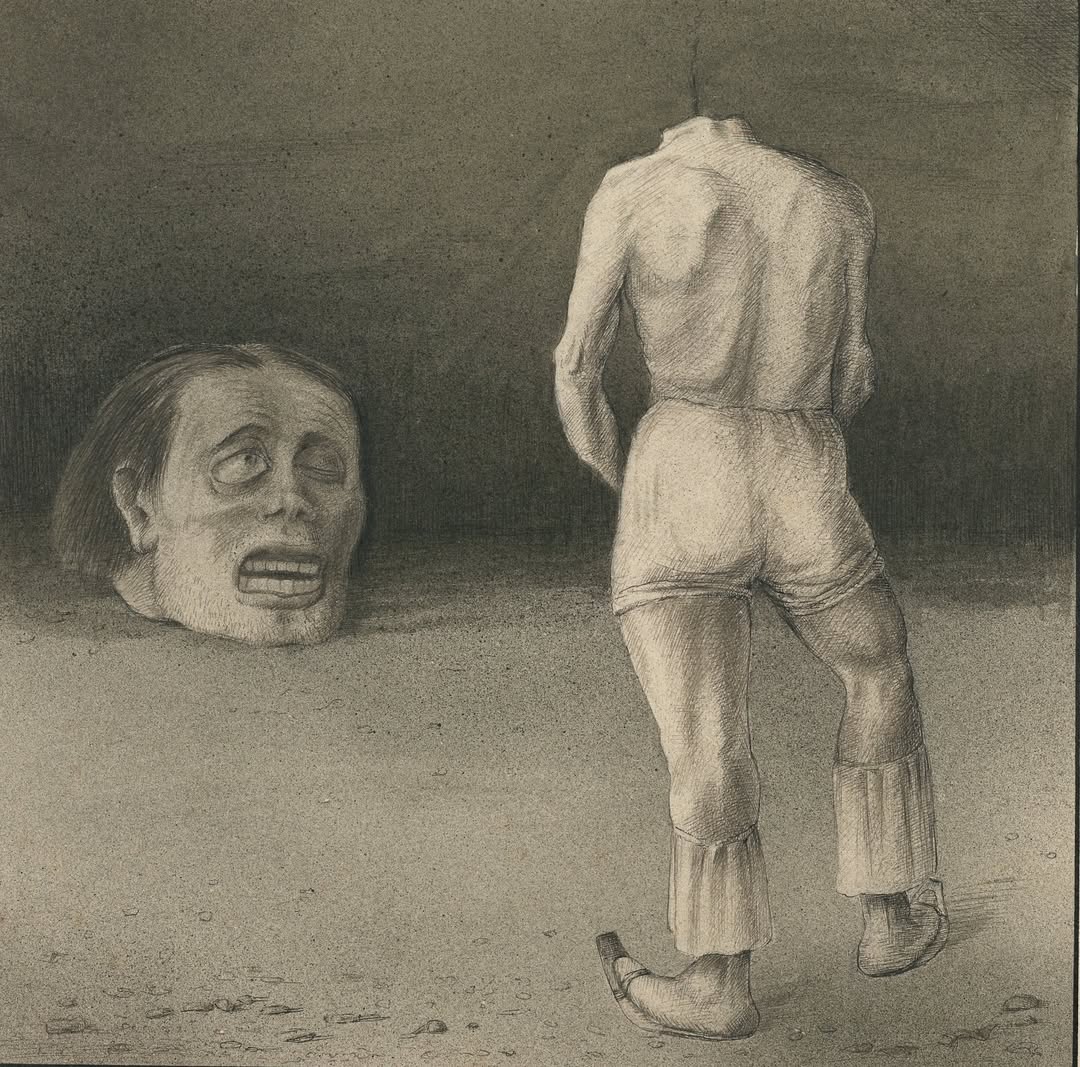
Self-Reflection, c.1901:02
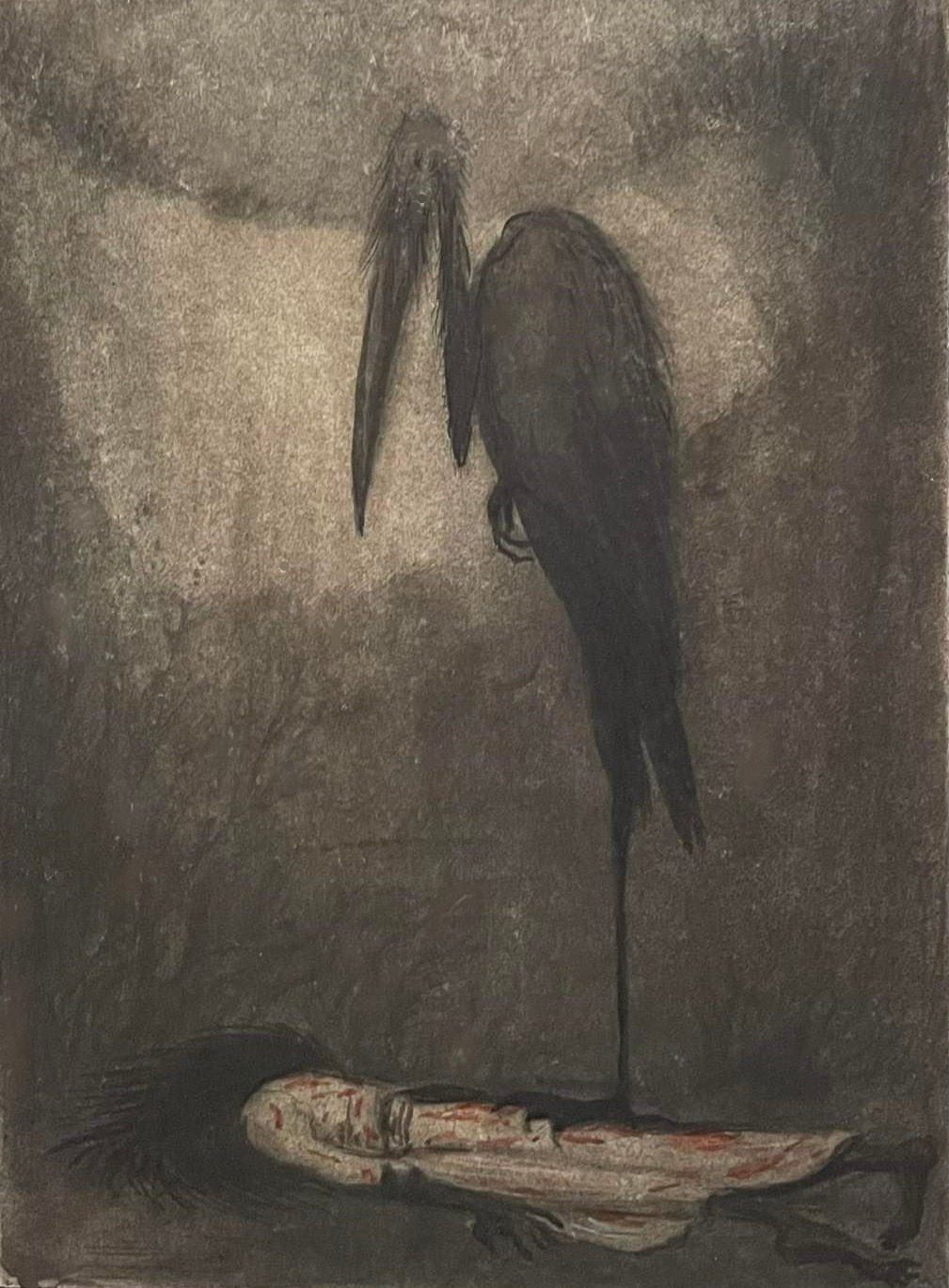
“Bird of Death”, n.d. Ink and watercolor on paper.
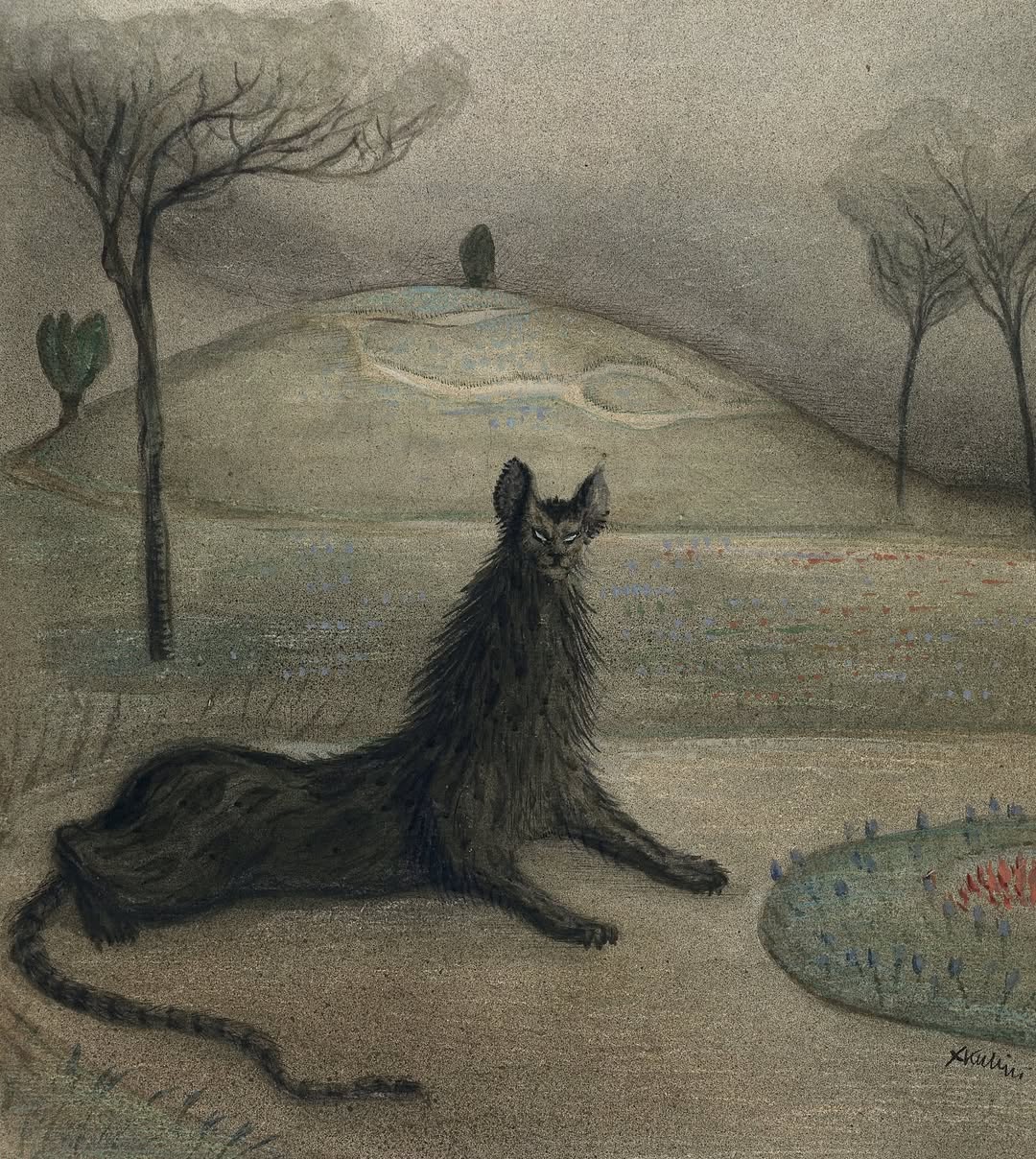
‘Dream Animal’ by Alfred Kubin, 1903.
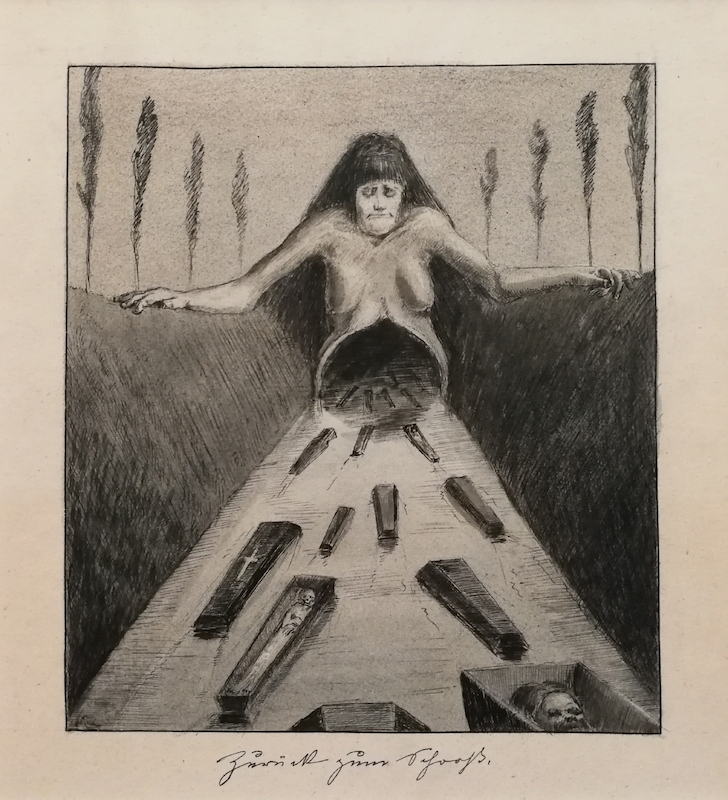
Back to the Womb
Via: Albertina, Sotheby’s, Steel Snowflake
Would you like to support Flashbak?
Please consider making a donation to our site. We don't want to rely on ads to bring you the best of visual culture. You can also support us by signing up to our Mailing List. And you can also follow us on Facebook, Instagram and Twitter. For great art and culture delivered to your door, visit our shop.
